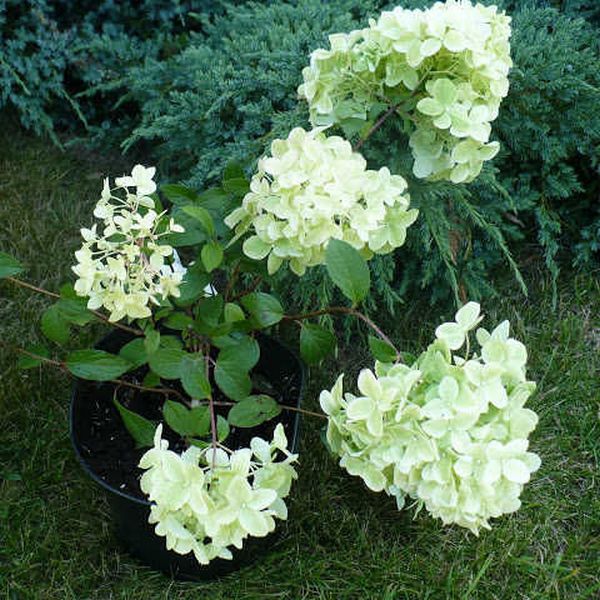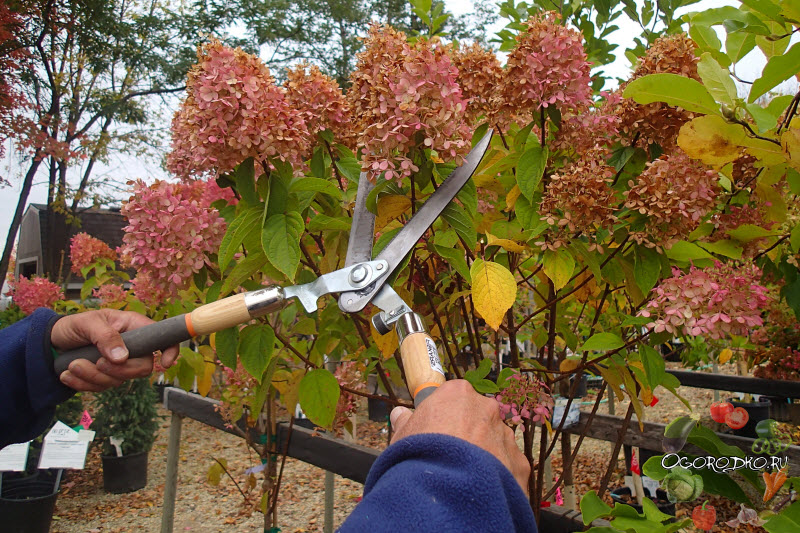Most often, Diamantino hydrangea is planted along garden paths or fences. This variety is considered one of the most popular among the whole variety of ornamental shrubs. Under favorable conditions, the cut can reach 4 m or more. In the northern regions, the height of hydrangea does not exceed 2 m.
The homeland of the shrub is Japan. In the 19th century, the plant came to France, where it became very popular at court. Court gardeners have bred a wide variety of varieties of hydrangeas that grow in our country. The bright and luxurious flowering of the bush has become the main reason that it is used when decorating garden and park areas.
The plant forms green leaves that are shaped like an egg. The edges of the leaf blade are slightly pointed. Flowers form lush caps of different colors at the ends of the branches. Their diameter can range from 10 to 20 cm. The flowering period lasts from early summer to early autumn.
Hydrangea Diamantino has a low index of winter hardiness and frost resistance. This requires gardeners to specially prepare hydrangea bushes for winter. Otherwise, the possibility of severe frostbite of young shoots and root system is not excluded.
The plant is light-loving. This means that the choice of a place when planting a hydrangea must be taken very carefully, it must be well illuminated by the sun.
Planting and leaving
Hydrangea Paniculata Diamantino will thrive in shaded areas. If the bush is exposed to direct sunlight, the ground underneath will dry out quickly, leading to a late onset of the flowering period.
You can plant a shrub in open ground in spring or autumn. If the local climate is cold, experienced gardeners recommend giving preference to spring planting. This will give the young plant enough time to settle down and grow stronger.
Before planting, you must first prepare the hole. Its dimensions can be in the range of 30 X 40 X 30 cm. The soil, which was removed when digging the planting hole, is mixed with mineral and organic fertilizers, as well as sand, peat and sod land.
When planting, all the roots of the plant must be shortened slightly with a sharp pruner. Having immersed the seedling in the hole, the roots must be carefully straightened and sprinkled with earth. The root collar should be at a height of 5 - 6 cm from the ground level. After falling asleep, the soil is compacted and watered. To prevent rapid drying of the soil, it is recommended to mulch it. For this, you can use humus or peat.
There are several breeding options for panicle hydrangea.
- Cuttings. Their harvesting is carried out from spring to mid-summer. To do this, it is recommended to take young shoots from 8 to 15 cm from the upper part of the crown. Remove everything from the lower part of the shoot and treat the stem with a growth stimulator. The cuttings prepared in this way are planted in a greenhouse in fertile soil. With the onset of spring, the cutting can be transferred to a permanent place in the open field.
- Bush division. This procedure can be performed in spring or autumn. In this case, the bush must be completely dug up and its root system must be divided into several parts.The division must be performed in such a way that there is a renewal kidney on each part. After that, parts of the shrub can be planted in a permanent place.
- Layers. For this breeding option, it is recommended to use young pagons, the age of which does not exceed 1 year. They are carefully bent to the surface of the ground and covered with soil. A part of the pagon remains on the surface, the length of which can be from 15 to 25 cm. After the seedling is well rooted, it can be separated from the main bush.
For abundant flowering, hydrangeas need feeding. You can use slurry or humus.
Experienced gardeners advise to water the plant little by little, but often. We must not forget about loosening the soil. During the season, the procedure is repeated 3-4 times. The depth of soil loosening can be in the range of 5-8 cm.
Pruning hydrangeas is done in the spring, before the buds swell on it. Thus, the crown of the bush can be given the desired shape, as well as dry branches damaged after winter can be removed.
Hydrangea needs preliminary preparation for the onset of cold weather. For this, young branches are shortened to 5 buds. The soil under the plant is covered with a layer of peat or humus. All branches are neatly tied into one bundle and bent to the soil surface, covered with insulation. To do this, you can use burlap or plastic wrap, and then sprinkle with sawdust or dry leaves. After that, the insulation is used again, which is securely attached to the ground.
You can remove the shelter only after it becomes clear that the spring frosts will not return.
Such simple procedures will ensure lush flowering of this beautiful shrub with the onset of summer.








